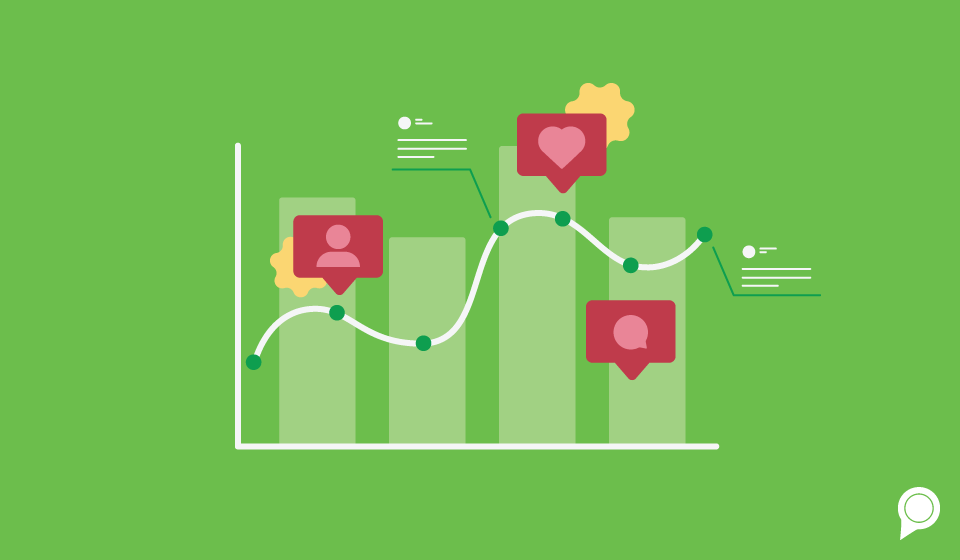

Social media is essential to any digital marketing strategy, and measuring its effectiveness is crucial for continued success. Social media key performance indicators (KPIs) are metrics that help you understand how well your social media marketing efforts are performing. By tracking KPIs, you can gain valuable insights into your audience's behavior, adjust your strategy accordingly and improve your social media ROI.
Even a top-of-the-funnel strategy like social media is important for the success of strategies lower in the funnel. Using social media well can offer exponential growth for your business’s conversion rates and overall revenue. This blog will show you what it means to have high-performing social media accounts and how to leverage essential KPIs.
The engagement rate measures how many people interact with your social media content. It includes likes, comments, shares, and other interactions. A high engagement rate indicates that your audience is interested in your content, which can lead to increased visibility and brand awareness from the algorithms.
Remember, social media users who don’t necessarily follow your account can engage with your post. For this example, we will calculate the engagement rate by followers to see how successful content is with your current audience. It is important to keep in mind other ways of calculating your engagement rate, as each can show a different value of importance. To calculate the engagement rate for a post: divide the total number of engagements (likes, shares, comments) by your number of followers, then multiply the quotient by one hundred. The percentage is the post’s engagement rate!
High-performing engagement rates are typically between 1%-5%. Remember that the higher your followership, the more difficult it is to achieve a high engagement rate. As your business accounts scale, don’t be discouraged! Learn from every insight and adjust as needed.
The follower growth rate measures the rate at which your social media following grows. This KPI is essential because it shows you whether your social media strategy effectively attracts and retains new followers.
Increasing followers will not always be a linear progression. Some posts will accrue many followers, some very little or none at all. The key is consistency over time and attracting the right followers who will offer your business the highest value.
Tracking which posts attract the most followers can provide insight into where to spend your creative energies and budget! Make sure to watch engagement rate as your follower growth rate increases to ensure your content is still relatable and earning engagements.
CTR measures how many people click on the links in your social media posts. This KPI is crucial if you use social media to drive traffic to your website or other platforms. A high CTR indicates that your audience is interested in your content and is more likely to convert.
CTRs are important because they show that users are moving down your business’s sales funnel. Offering frequent, but not overbearing, CTAs on your social media accounts gives users more ways to connect with your brand and leads them further towards becoming customers!
The conversion rate measures how many people take the desired action on your website or other platforms after clicking on a social media link. It is an important KPI because it shows you how effectively your social media marketing efforts drive conversions and generate revenue.
Sentiment analysis measures how your audience feels about your brand and your content. By tracking sentiment, you can identify areas where your audience is dissatisfied and make changes to improve their experience. You can track sentiments by reading comments, sharing posts or social media reviews and mentions.
Tracking positive and negative sentiments is important for developing new strategies and supporting others. Hiring a Social Listener or periodically checking comments and reviews can ensure no opportunity is missed.
Keeping a pulse on those five KPIs can give you valuable information on improving your business’s social media performance and offer hard data on what works and what doesn’t. While paying attention to likes, shares and follower count, may be tempting, those metrics are often something we call vanity metrics.
Vanity metrics are metrics that don't necessarily provide meaningful insights into the success of their marketing efforts. They can make a person or business feel good about their social media performance but don’t offer real insights. Some common vanity metrics for social media include:
While social media marketing is a top-of-the-funnel strategy, there are KPIs to measure that directly support driving conversions and business revenue. Staying focused on the KPIs that matter and steering clear of vanity metrics can transform your business’s social media performance and mean significant growth for your bottom line!
RevLocal handles social media strategies and all things digital marketing for small businesses and multi-location brands. To learn more about who we are and what we do, contact us for a free consultation!
Subscribe to our email list to get the latest digital marketing content delivered to your inbox each week!